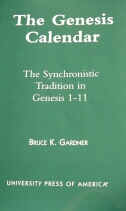The Genesis Calendar
The Synchronistic Tradition in Genesis 1-11
by
Bruce K. Gardner

University Press of America 2001
ISBN 0-7618-1969-X
xx+374 pages
The Genesis Calendar
The Synchronistic Tradition in Genesis 1-11
by
Bruce K. Gardner

University Press of America 2001
ISBN 0-7618-1969-X
xx+374 pages
| This review is available as PDF-file only. |
|
(Review no. 3: “The Genesis Calendar - The Synchronistic Tradition in Genesis 1-11” by Bruce K. Gardner) Dr. Bruce K. Gardner has written an extensive analysis of the calendars probably in use during the Second Temple period in Israel. His book is structured by 6 problems: (1) “understanding Hebrew lunar evidence”, (2) “the Hebrew calendar’s contexts”, (3) “the Mishnah’s out-of-step calendrics”, (4) “364-day calendars and intercalation”, (5) “the ‘Key of Enoch’ and PH [Primeval History] calendrics”, (6) “pre-history of Qumran’s synchronism”. The chapter about problem 5 is the center of his presentation, which is the part of the book this review is concerned with only. Gardner believes to have found ‘The Genesis Calendar’ in the genealogical pedigree in the eleventh chapter of the Book of Genesis, encoded by the ‘Key of Enoch’: the years of the ages of the patriarchs are to be counted as days. He considers this calendar to be part of a synchronistic tradition, meaning that several different calendars like solar and luni-solar were in use simultaneously, like e.g. the calendars known from Qumran. However, the only piece of information hinting at a 364-day year is the sum total of all the ages of the 7 patriarchs from Arpachshad to Nahor in the Massoretic Text, which is 2191, a number which does not occur in the text. 2191 days can be interpreted as an intercalated 6-year-cycle of 364-day-years being an approximate 6-year-cycle of solar years: 6 * 364 + 7 = 2191 days ≈ 6 solar years ≈ 6 * 365.25 days = 2191.5 days
In a detailed analysis of the other numbers of Gen.11, Gardner ‘finds’ 12 months of a lunar year as well. The proof for the existence of this synchronistic calendar tradition in Genesis 11, which Gardner believes to have found, can not be confirmed by this reviewer. Gardner’s procedures to obtain his results are really smart, but it is very likely to find similar solutions, like e.g. the Meton cycle, by allowing so many free parameters to enter the system as he did. Unfortunately, he does not do any statistical tests at all. |
© seit 2005 Rüdiger Heinzerling